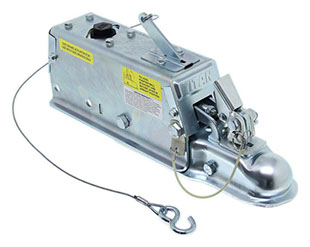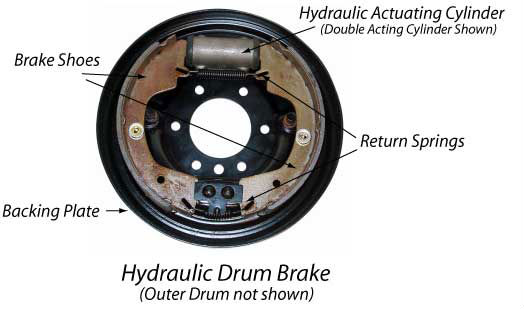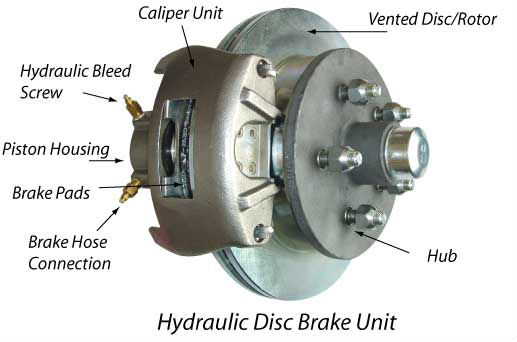Hydraulic Surge Braking
Surge Couplers

Surge couplers use a spring or fluid dampened movable coupling head which uses the tow vehicles momentum and braking to operate a hydraulic master cylinder (a small manual hydraulic pump). As the tow vehicle brakes, the trailer "surges" forward, and this surging forces the movable part of the coupling backwards. The rearward movement of the coupling "pumps" the master cylinder which sends pressurized brake fluid to the brakes (see below). Surge couplers are available for trailer braking up to 10,000 lbs. Click here for more information on Trailer Couplers.
Hydraulic Surge Braking
The simplest braking is hydraulic surge braking and overall this system works well with both braking efficiency and control. The hydraulic master cylinder attached to the spring or fluid dampened coupler softens the impact of the coupler motion and gives a proportional amount of braking control.
Hydraulic drum brakes tend to have smoother braking over disc brakes, and this makes them especially suited to trailers where the cartage of livestock or fragile loads is undertaken.

Drum brake load ratings are up to 9000 lb per axle although 3500 lb load rating is common. Disc brake load ratings range between 2000 lb up to 9000 lb per axle.
Hydraulic override/surge braking operating disc brakes are probably the most common type of braking on trailers up to 5500 lb. They are easy to install and set up, require less maintenance than drum brakes and spare parts are readily available.

If a fluid dampened coupler is used, braking sensitivity is increased and braking of the trailer becomes more proportional to the tow vehicle for both drum and discs.
Hydraulic Breakaway Brakes
Modern hydraulic surge couplers come complete with an in built breakaway lever which again is activated by a tether cable attached to the tow vehicle.
When the trailer comes adrift from the tow vehicle, the tether cable will manually actuate the master cylinder and apply hydraulic pressure to the brakes. In most cases the cable will lock in its pulled/activated position retaining pressure on the brakes. Simple and effective if maintained correctly.
Check your coupler manufacturer maintenance booklet to see what is required for testing the breakaway unit and most importantly any maintenance and lubrication requirements.
Electric over Hydraulic Braking (EOH)
A step up from surge braking is using an electric pump to supply pressurized hydraulic fluid to either drum or disc brakes - click here for more details.